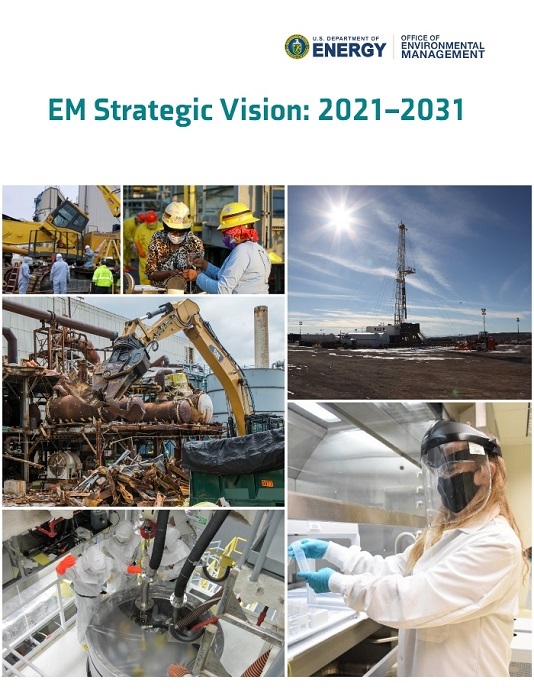 A past visual verification of low-level waste conducted at the Nevada National Security Site.
Two EM programs recently collaborated to enhance an established radioactive waste inspection process, allowing for continued safe, secure, and compliant waste shipments from one DOE site to another, while minimizing travel and person-to-person contact during the COVID-19 pandemic.
Personnel from the Idaho National Laboratory (INL) Site and EM Nevada Program integrated remote communications tools to enhance required visual inspections of waste containers to be shipped from Idaho to the Nevada National Security Site (NNSS) for ultimate disposal.
To make it happen, Stuart Gerard, waste certification official for EM INL Site contractor Fluor Idaho, provided Radioactive Waste Acceptance Program (RWAP) specialist Ann Koplow with a DVD containing real-time radiography imaging of filled waste containers in Idaho to be verified. Koplow is an employee with Navarro Research and Engineering, Inc., the environmental program services contractor responsible for administering the RWAP on behalf of EM Nevada. Real-time radiography works much like an X-ray, allowing a RWAP professional to view the contents inside of a waste container.
From a laptop at her telework location in Nevada, Koplow reviewed the video to ensure the contents of each container met both the waste profile descriptions and permit requirements for disposal at the NNSS. Koplow completed her remote visual verification using a secure smartphone application and Gerard’s help to give her a real-time look at the final placement and closure of the containers.
This application of technology saved days of RWAP travel to and from Idaho, avoiding ancillary expenses. Most importantly, the virtual visual verification process eliminated the need for direct contact between the Nevada and Idaho program workforces, reducing the risk of COVID-19 transmission among the sites.
“Despite the challenges posed by the COVID-19 pandemic, our team has remained fully committed to the safe, secure, and successful execution of EM Nevada’s waste management mission,” said Koplow. “We thank our partners at the Idaho National Laboratory Site for helping to enhance our vital waste verification processes during the current period of adjusted operations.”
Gerard noted that the COVID-19 pandemic led the INL Site and EM Nevada programs to think outside the box to fulfill the cleanup mission.
“I appreciate EM Nevada’s assistance in developing an innovative solution to enhance their waste inspection process to allow us to continue to meet our regulatory agreements,” Gerard said.
The NNSS plays a pivotal role in the cleanup of DOE sites involved in historic nuclear research, development, and testing, and ongoing national security and science missions by providing a safe, secure, and effective asset for the permanent disposal of low-level, mixed low-level, and classified radioactive waste.
Waste disposed at the NNSS is only accepted from approved federal sources and must comply with rigorous NNSS waste acceptance criteria. The INL is required to ship specific wastes out of Idaho in compliance with the 1995 Idaho Settlement Agreement.
-Contributor: Kevin Knapp, Erik Simpson
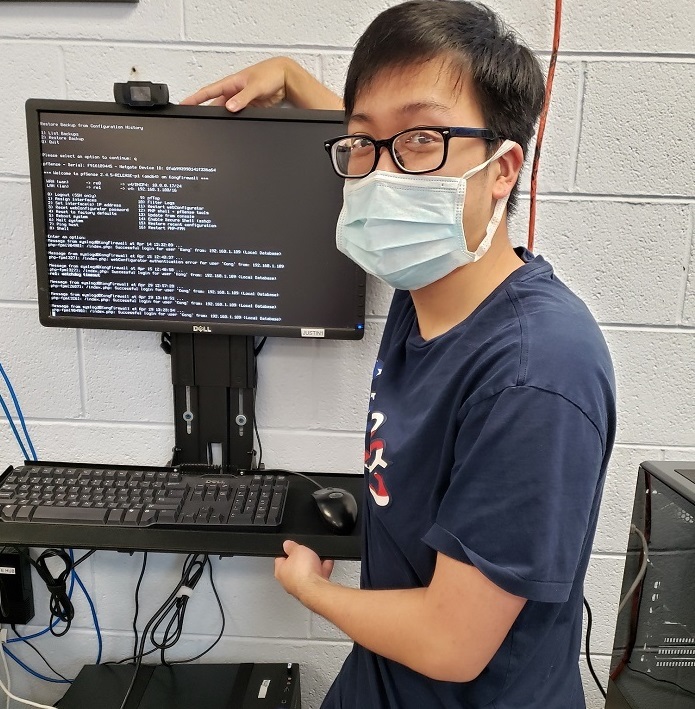 Kien Nguyen, a student at Bearden High School in Knoxville, Tennessee, was the lead student on a project funded by a grant UCOR awarded last year to teach students about cybersecurity firewalls. The school won multiple UCOR grants this year.
OAK RIDGE, Tenn. – Oak Ridge cleanup contractor UCOR is awarding $30,000 in grants for science, technology, engineering, and mathematics (STEM) projects to benefit 30 schools across a nine-county region.
Since 2012, UCOR has given more than $230,000 in grants to local schools to support STEM education and help develop the next-generation workforce.
This year, the contractor awarded grants for 40 projects with titles such as “The Science Behind a Coffee Shop,” “Ozobots,” “Develop Computational Thinking,” and “Elementary Coding and Robotics.”
“This program is a highlight every year,” said Jay Mullis, manager of the Oak Ridge Office of Environmental Management. “We appreciate UCOR’s continued focus in this area, which is giving teachers resources to offer students interesting STEM projects that build their interest in these fields.”
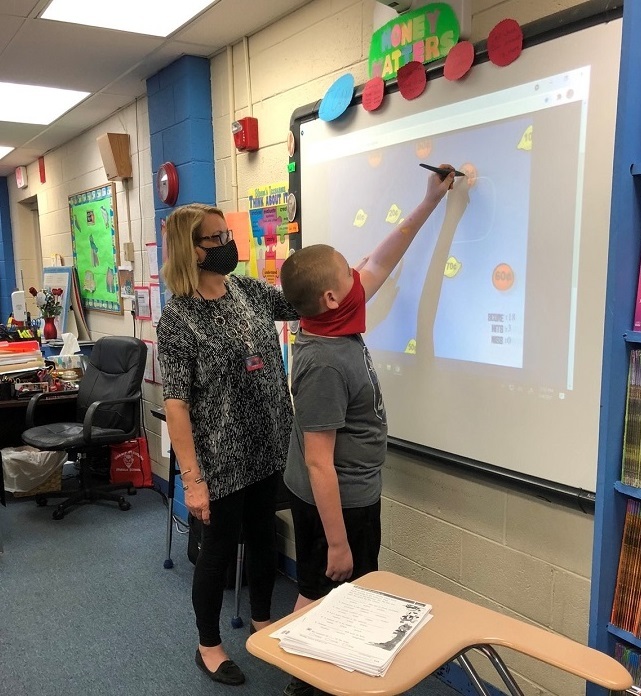 Sarah Maness, a teacher from Horace Maynard Middle School in Maynardville, Tennessee, is a 2021 UCOR grant recipient. Maness is shown introducing a student to a science, technology, engineering, and mathematics (STEM) project.
Award recipient Donna Tompkins, a fourth grade science teacher at Oneida Elementary School in Oneida, Tennessee, has an after-school STEM club for fourth and fifth grade students. In the “May the Force be With You” project, her students will build and modify sail cars for the best speed and distance by experimenting with different types of sails and wheels. Sail cars often work like a sailboat, operated from a sitting or lying position and steered by pedals or hand levers.
“I want to get my students interested in STEM at an early age and to learn how to design, build, test, and improve their designs,” Tompkins said. “This building, testing, and design modifying will take place through teamwork, a skill I feel is very valuable for success in the real world.”
Sarah Maness, a special education teacher at Horace Maynard Middle School, in Maynardville, Tennessee, said the grant will help her provide sixth, seventh, and eighth grade students access to STEM materials that fit their needs and abilities.
“My goal is to get them interested in new opportunities, focus on teamwork, and experience open-ended exploration,” Maness said. “Our STEM for ALL program will create the space with the appropriate materials to allow everyone to explore STEM and open their eyes to future endeavors.”
UCOR President and CEO Ken Rueter said the STEM grants program supports the company’s workforce development program and is an important way to support the communities in which UCOR employees live and work.
A chemical engineer, Rueter noted that UCOR’s work to turn decades-old environmental hazards into reusable land requires a workforce with a large number of STEM professionals. UCOR’s workforce includes engineers, industrial hygienists, nurses, project managers, chemical operators, and electricians.
“We need workers from multiple disciplines to maintain the kind of trained, skilled workforce needed to successfully advance EM’s charge to complete environmental cleanup across the Oak Ridge Reservation,” Rueter said.
-Contributor: Wayne McKinney
A crew with Office of River Protection tank farms operations contractor Washington River Protection Solutions sets up a work platform to take a core sample from double-shell Tank AN-101. Core samples provide engineers with valuable data in their efforts to combat corrosion and maintain the structural integrity of Hanford’s double-shell waste storage tanks.
RICHLAND, Wash. – EM's Office of River Protection (ORP) and tank farms operations contractor Washington River Protection Solutions (WRPS) continue to advance a comprehensive program to ensure the structural integrity of the Hanford Site’s underground waste storage tanks.
Through a process called “core sampling,” engineers collect waste from deep inside underground double-shell waste-storage tanks to gain valuable information, such as waste chemistry, corrosion rates, and the likelihood of “pitting,” in which small, deep holes are created, or stress corrosion cracking of the steel tanks. Workers collect samples of the tank solids and waste from selected waste layers, going as low as 1 inch from the bottom of the 47-foot-deep tank.
“The data obtained through core sampling helps develop or modify mitigation strategies designed to extend the service lives of double-shell tanks,” said ORP’s Erik Nelson, program manager with the tank farms program division. “The integrity of double-shell tanks ensures the continued safe storage of millions of gallons of waste and availability of tank space to support waste treatment operations.”
Hanford’s underground tanks store waste from more than four decades of plutonium production. The tanks are made of carbon steel and reinforced concrete. WRPS is retrieving and transferring waste from older single-shell tanks to more robust double-shell tanks. Each of the 27 double-shell tanks in service has a capacity of approximately 1 million gallons.
WRPS recently began collecting core samples from Tank AN-101, the fourth of Hanford’s double-shell tanks to be core sampled in the past two years. The samples are sent to Hanford’s 222-S Laboratory, where scientists determine the waste makeup and perform electrochemical corrosion tests.
“Core sampling allows us to get what we really need: a vertical profile of the waste, including the waste in contact with the tank bottom,” said Ruben Mendoza, who manages the WRPS Tank and Pipeline Integrity Program. “In addition, the data is used to update waste composition estimates, verify criticality safety, and aid in long-term strategic mission planning.”
Criticality safety is the prevention of nuclear and radiation accidents resulting from an inadvertent, self-sustaining nuclear chain reaction of radioactive materials.
Core sampling is one component of the comprehensive tank integrity program. In recent years, EM and WRPS have developed and deployed innovative robotic systems for visual inspections of double-shell tank bottoms. Development is ongoing to deploy robotic systems for ultrasonic inspections of the tank bottom to detect thinning, pitting, and cracking.
-Contributor: Mark McKenna
 Information technology field support specialist Chris Martin takes part in a disaster recovery exercise on the Hanford Site, which tested critical systems and upgraded data storage capacity.
RICHLAND, Wash. – Disaster recovery testing teams recently conducted a behind-the-scenes emergency drill at the Hanford Site, assessing capabilities while also upgrading data storage and improving system performance during a weekend service outage.
Teams from EM Richland Operations Office contractor Hanford Mission Integration Solutions (HMIS) and its subcontractor North Wind Solutions deactivated Hanford’s two data centers to make updates and test disaster recovery capabilities and planning. Usually information management staff members deactivate only one data center during a disaster recovery exercise, but this test proved the Hanford systems and processes could handle a potential catastrophe at either center without the loss of data.
“Our proactive approach to information management prioritizes the need to plan ahead and prepare for the possibility of a disaster, including effects on data,” said Mike Eddy, EM information management chief information officer. “We regularly conduct system checkups, and this exercise stepped up the scale to a potential total loss of power or destruction of either data center.”
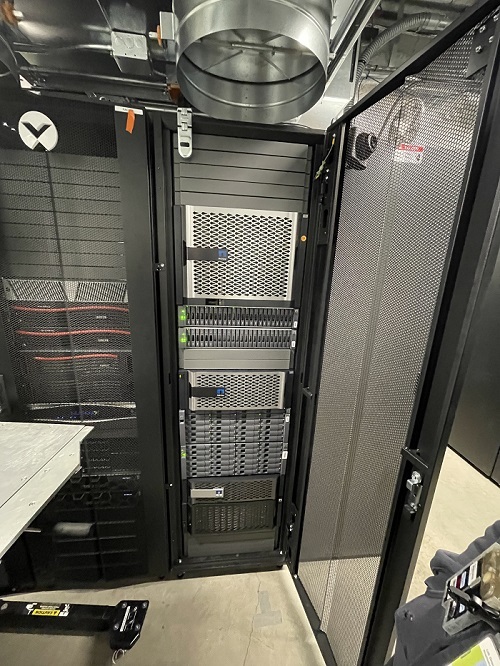 |
|
Teams with Hanford Mission Integration Solutions put two Hanford Site data centers to the test over a weekend recently, successfully running disaster exercises and upgrading capabilites to improve performance. |
Hanford’s two data centers passed a catastrophe-simulation test while maintaining and protecting data. Teams also upgraded the data storage system capacity to enhance performance for the thousands of Hanford Site workers. |
|
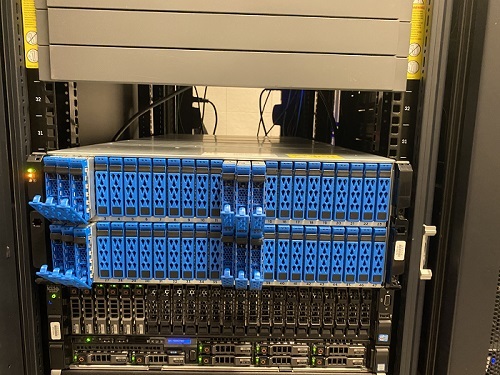 |
Information technology specialists prepared for months leading up to the exercise, swapping out physical equipment and readying the system for the upgrade. During the actual disaster scenario, most participants worked remotely to run emergency sequences while also improving data reliability.
“I am very proud of our team for the successful modernization of our Hanford data storage systems, which will also improve performance for our users at Hanford,” said Todd Eckman, vice president of information management services for HMIS. “Thanks to rigorous planning, the corresponding disaster recovery and continuity of operations exercise exceeded expectations.”
-Contributor: Robin Wojtanik
Members of the Seneca Nation of Indians and others from the community gather at the West Valley Demonstration Project for a sunrise ceremony before beginning activities to mark Earth Day.
WEST VALLEY, N.Y. – Members of the Seneca Nation of Indians kicked off an event to mark Earth Day this year at EM’s West Valley Demonstration Project with a sunrise ceremony, paying tribute to the earth and raising awareness of the need to protect the Cattaraugus Creek watershed for future generations.
“Each step taken today is a prayer for healing for all our relations,” said Maria Maybee, the event coordinator with the Seneca Nation. “This event is a reminder that we must work together to protect the environment, for it provides everything we need in life. It’s important that this message is never forgotten, for we only have one environment.”
Maybee asked everyone at the gathering to form a circle as a symbol of togetherness. Participants received tobacco, which was used to communicate prayers to the spirits. They also voiced prayers, with some praying for employees at WVDP to remain safe as they continue EM’s cleanup mission to reduce legacy risks at the site. They played drums and sang a song, welcoming the sun.
Next, participants went for a walk, cleaned up the banks of the Cattaraugus Creek, and went kayaking and rafting. The following day, they cleaned up a beach along the creek within the Seneca Nation territory.
“We enjoy the many offerings Mother Earth provides, from water to drink and vegetables to eat,” Maybee said. “However, it’s important that we protect these natural resources from harm, especially for future generations to benefit from these offerings.”
-Contributor: Joseph Pillittere
|


